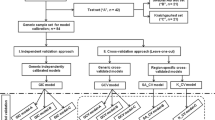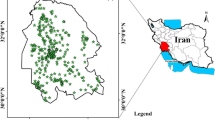Abstract
Soil chemical properties from different locations in the Trier region, Rhineland-Palatinate, SW Germany were evaluated using VIS/NIR reflectance spectrometry (ASD FieldSpec-II spectrometer, 0.4–2.5 μm) and partial least-square regression (PLS). Generally, laboratory spectrometry performed better than field spectrometry probably due to strong interferences of soil structure. In a plot experiment reliable estimations were obtained for total amounts of Ca, Mg, Fe, Mn and K but not for organic carbon and nitrogen. In the landscape-scale context the estimations for organic carbon could be significantly improved but it was also concluded that the development of statistical prediction models is limited to geologically homogeneous areas. In both experiments CAL extractable nutrients could not be satisfactorily estimated. This excludes diffuse VIS/NIR spectrometry as a diagnosis tool of short- or medium-term changes of the soil's nutrient status. However, the method can be used as a quick screening method in questions where the spatial distribution of organic carbon and total metal contents is addressed, as in soil development and soil degradation monitoring, and when time or laboratory costs are critical factors.
Similar content being viewed by others
References
Al-Abbas A H, Swain P H and Baumgardner M F 1972 Relating organic matter and clay content to the multispectral radiance of soils. Soil Sci. 6, 477–485.
Baumgardner M F Silva L F, Biehl L L and Stoner E, 1985. Reflectance properties of soils. Adv. Agron. 38, 1–44.
Ben-Dor E and Banin A 1995a Near infrared analysis (NIRA) as a rapid method to simultaneously evaluate several soil properties. Soil Sci. Soc. Am. J. 59, 364–372.
Ben-Dor E and Banin A 1995b Near infrared analysis (NIRA) as a simultaneous method to evaluate spectral featureless constituents in soils. Soil Sci. 159, 259–269.
Ben-Dor E, Irons J R and Epema G 1999 Soil reflectance. In Remote Sensing for the Earth Sciences, Vol. 3. Ed. A N Rencz. pp. 111–188. Wiley, New York.
Couillard A, Turgeon A J, Westerhaus M O and Shenk J S 1997 Determination of soil separates with near infrared reflectance spectroscopy. JNIRS 4, 201–212.
Galvão L S, Pizarro M A and Epiphanio J C N 2001 Variations in reflectance of tropical soils. Spectral-chemical composition relationships from AVIRIS data. Remote Sens. Environ. 75, 245–255.
Hill J and Schütt B 2000 Mapping complex patterns of erosion and stability in dry Mediterranean ecosystems. Remote Sens. Environ. 74, 557–569.
Hill J, Mégier J and Mehl W 1995 Land degradation, soil erosion and desertification monitoring in Mediterranean ecosystems. Remote Sens. Rev. 12, 107–130.
Hunt G R and Salisbury J W 1970 Visible and near-infrared spectra of minerals and rocks I Silicate minerals. Mod. Geol. 1, 283–300.
Hunt G R, Salisbury J W and Lenhoff C J 1971 Visible and near-infrared spectra of minerals and rocks III. Oxides and hydroxides. Mod. Geol. 2, 95–205.
Kosmas C S, Curi N Bryant R B and Franzmeier D P 1984 Characterisation of iron oxide minerals by second-derivative visible spectroscopy. Soil. Sci. Soc. Am. J. 48, 401–405.
Krishnan P Alexander D J Butler B and Hummel J W 1980 Reflectance technique for predicting soil organic matter. Soil Sci. Soc. Am. J. 44, 1282–1285.
Martens H and Naes T 1989 Multivariate Calibration. JohnWiley & Sons Ltd., Chichester. 420 pp.
Nette T 2001 Geo-Informationssysteme als Instrument des Ressourcenmanagements für Belange des Boden-und Gewässerschutzes. Dissertation im Fachbereich VI Geographie/ Geowissenschaften an der Universität Trier. 251 p.
Otto O 1998 Statistics and Computer Application in Analytical Chemistry. Wiley-VCH, Weinheim. 314 pp.
Plant R E 2001 Site-specific management The application of information technology to crop production. Comput. Electron. Agric. 30, 9–29.
Savitzky A and Golay M J E 1964 Smoothing and differentiation of data by simplified least square procedure. Anal. Chem. 36, 1627–1638.
Schnug E, Panten K and Haneklaus S 1998 Sampling and nutrient recommendations – The future. Commun. Soil Sci. Plant Anal. 29, 1455–1462.
Schepers J S and Francism D D 1998 Precision agriculture –What's in our future. Commun. Soil Sci. Plant Anal. 29, 1463–1469.
Schüller H 1969 Die CAL-Methode, eine neue Methode zur Bestimmung des pflanzenverfügbaren Phosphates im Boden. Z. Pflanzenern. Düng. Bodenk. 123, 48–63.
Shepherd K D and Walsh M G 2002 Development of reflectance spectral libraries for char-acterization of soil properties. Soil Sci. Am. J. 66, 988–998.
Torrent J, Schwertmann U, Fechter H and Alferez F 1983 Quantitative relationships between soil color and hematite content. Soil Sci. 6, 354–358.
Viscarra-Rossel R A and McBratney A B 1998 Soil chemical analytical accuracy and costs Implications from precision agriculture. Aust. J. Exp. Agric. 7, 765–775.
Watanabe F S and Olsen S R 1965 Test of an ascorbic acid method for determining phosphorus in water and Na-bicarbonate extracts from soil. Soil Sci. Soc. Am. Proc. 29, 677–678.
Wilcox C H, Frazier B E and Ball S T 1994 Relationship between soil organic carbon and Landsat TM data in Eastern Washington. Photogramm. Eng. Remote Sens. 6, 777–781.
Author information
Authors and Affiliations
Rights and permissions
About this article
Cite this article
Udelhoven, T., Emmerling, C. & Jarmer, T. Quantitative analysis of soil chemical properties with diffuse reflectance spectrometry and partial least-square regression: A feasibility study. Plant and Soil 251, 319–329 (2003). https://doi.org/10.1023/A:1023008322682
Issue Date:
DOI: https://doi.org/10.1023/A:1023008322682




